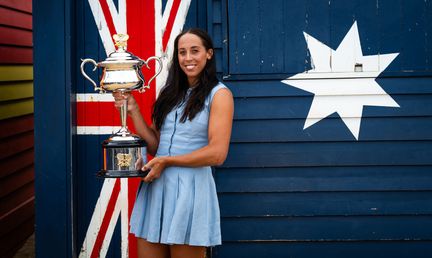PARIS -- A few weeks ago in Rome, Iga Swiatek was asked about her new-and-improved serve, the distinctive, now slightly abbreviated offering that has helped her navigate to the quarterfinals at Roland Garros.
“That’s weird,” said Swiatek, looking a little perplexed. “Honestly, I keep laughing about my serve, but I know it’s pretty good. I wouldn’t be here if it wasn’t. I wasn't aware of the stat.”
Heading into Paris, no one who has played more than 10 matches this year wins a higher percentage of service games (83.6), service points (64.5) or break points saved (71.4). Since shortening her motion to the ball since the start of 2024, Swiatek has become more consistent. And when you’re already the World No.1, that means trouble for the rest of the field.
The service at an outside café in this city of light, especially if you aren’t a local, can be dodgy at times. The same is true on these baked red courts in Paris.
Le service is a player’s soul laid bare, a very public measure of a very private resource -- confidence. It’s the first and most important strike of the point. The idea is to create a series of linked events that is repeatable -- especially when circumstances become difficult. Easier said than done.
The service motion is a personal thing, something most players have been doing almost unconsciously for many years. But in professional tennis, like all sports, if you’re not improving, you’re probably falling behind.
It’s not a coincidence that the WTA Tour’s three top-ranked players have all tinkered with their service approach over the past two years.
No.3-ranked Coco Gauff, for example, has lowered her toss and simplified her motion.
“If I want to be the player that I want to become, I have to be uncomfortable and make changes to my game,” she said before the tournament. “I feel like it’s getting better. But it’s obviously a shot that I feel is tough to change just because when you’re tight or whatever, you kind of revert back to what you know works.”
Smoother, shorter, better
Mary Carillo, working as a NBC Sports analyst here, has the formula for success.
“One, hold serve. Two, have one strength. Three, hide your weakness. That’s it,” Carillo said. "Hold serve and have a strength, hold serve and hide a weakness. But of the three, holding serve is the key.”
It’s basically true of any Grand Slam. Carillo, inspired, stood up (despite wearing a walking boot) and demonstrated the ideal, fluid serve.
“You watch any great server, the rhythm is always down, up, hit. Down, up and hit -- that is the rhythm. If Coco’s toss is wandering -- if you have to have good footwork to serve -- that’s not good.”
Carillo went on to cite the serves of Elena Rybakina and Aryna Sabalenka (more about her later) as particularly fluid and beautiful.
“Iga’s serve, to me, looks very measured,” she said.
Swiatek’s service is a little unorthodox. To begin, she rests her white Tecnifibre Tempo 298 racquet against the ball, leans backward and then very slowly pulls it sideways with her right hand, almost parallel to the ground -- and tosses the ball. Then, picking up speed, she brings the racquet 90 degrees, up to perpendicular and turns her wrist back and cocks the racquet. Shifting her weight forward, she accelerates the swing and, with her feet about six inches off the ground, meets the ball.
In Swiatek’s words, “We changed the whole movement before the shot, basically.”
Swiatek held her arms out to her sides to indicate the original position, then raised them higher into more of a “V” for the current technique.
“We’re making it more smooth and shorter, so I don’t have time to stutter under pressure.”
How much to go for? When to dial it back? Good players feast on weak second serves -- and don’t mind missing a few -- because the risk/reward ratio is attractive. So how do you find the balance of consistently landing an effective first serve without missing too many and getting burned on the second?
This is something Gauff has been wrestling with since recently changing things up. On her way to the quarterfinals here in Paris, she’s won 29 matches already this year but leads all players with 229 double faults. In the Rome semifinal against Swiatek, she only had four -- but they cost her two critical breaks of serve and, ultimately, the match.
“Overall,” she said, “if I’m going 120 [miles per hour] on the serves, I have to expect that.”
Like Swiatek, Gauff has shortened the racquet’s path to the ball. She, too, is holding her hands higher to shorten the process and is conscious of not dipping her left shoulder too low. That simplified motion means less can go wrong. It’s the same theory behind lowering the toss. Years ago, coach Brad Gilbert had Andy Roddick bring it down a bit and, as a result, he became more consistent. Gilbert recently made the same adjustment with Gauff.
“Some people have a high toss and do perfectly fine,” Gauff said after her first-round win. “I think for me, when your toss is higher, you just have more room for error. Also, I kind of changed the way I toss, so naturally it brought it down.”
Against Julia Avdeeva, Gauff won 23 of 24 first-serve points and hit only four double faults.
“I think my serve is always decent and could be a weapon when it’s on, but it’s about making it more consistent,” Gauff said. “I think match by match it’s getting better, and I’m pretty confident now with it.”
A mechanical issue
Sabalenka, who Monday reached the quarterfinals of the French Open for the second straight year, is intimately familiar with double faults. Two years ago, they almost defeated her.
She was asked in Paris about the yin and yang of aces and double faults.
“I think generally you kind of focus on negative things more than positive,” Sabalenka said. “When you’re double-faulting a lot you don’t care about those aces, you just want to fix this issue.
“Nobody will understand that better than me.”
Two years ago, Sabalenka tied for sixth in aces, with 249. Not bad, but she also fired 428 double faults -- 139 more than anybody else. The breaking point came during the summer in Toronto, when she couldn’t stop sobbing.
One of her coaches, Jason Stacy, challenged her to fix it. And that meant completely redesigning the service motion that had gotten her all the way to the No.2 ranking. With the help of Gavin MacMillan, a former player and an expert in biomechanics, Sabalenka did it.
MacMillan convinced her that, despite most people’s perceptions, double faults are more a matter of mechanics than mentality. He completely overhauled her motion, moving her tossing hand and changing the alignment of the racquet and her body with it.
Last year, Sabalenka hit only 285 double faults, averaging four per match -- about half the previous year’s average. This year, she’s trimmed it to about three per match.
Sabalenka, Swiatek and Gauff were brave enough to change the way they did business and, considering the early returns -- so to speak -- it seems to be working.
It’s instructive that Swiatek sees her serve as a work still in progress. In Rome there were times in the final against Sabalenka when her first serve bailed her out of difficult spots.
“Changing the technique, I think it allowed me to serve faster,” she told reporters in Rome. “And we worked on my placement as well, so it got better for sure. I feel like I have more options when I’m serving.”
Gauff acknowledges the difficulty of making changes during the season, sometimes in-tournament manipulations.
“I think it’s just finding the balance of going big, but also knowing when to slow down the pace just to get the serve in,” Gauff said. “Honestly, I bet on myself to continue to go big. I know when I go big and my serve goes in, it’s dangerous. I’m trying to think long term. I don’t want to lose the 120 [mph] serve by not going for it.”
Swiatek is already looking past these recent tweaks.
“I think overall the coach [Tomasz Wiktorowski] from the beginning had a great idea about my serve,” she said. “Next goal is to keep my serve at a consistent level throughout the whole season.
“We are working hard for the movement to be smooth and to get muscle memory, so even under the biggest pressure and stress, I’m going to be serving the same way. So we’ll see about that.”




![[WC] Sorana Cirstea d. [8] Emma Navarro 7-6(5), 3-6, 7-5, Dubai R3 (3:01). Cirstea held on to notch the 24th Top 10 win of her career and reach the Dubai quarterfinals for the second straight season.](https://photoresources.wtatennis.com/photo-resources/2025/02/19/03a81ffa-191c-468a-8bc0-64546e4aa6e7/Sorana_Cirstea_-_Dubai_Duty_Free_Tennis_Championships_2025_-_Day_4-DSC_6614A.jpg?width=451&height=268)




